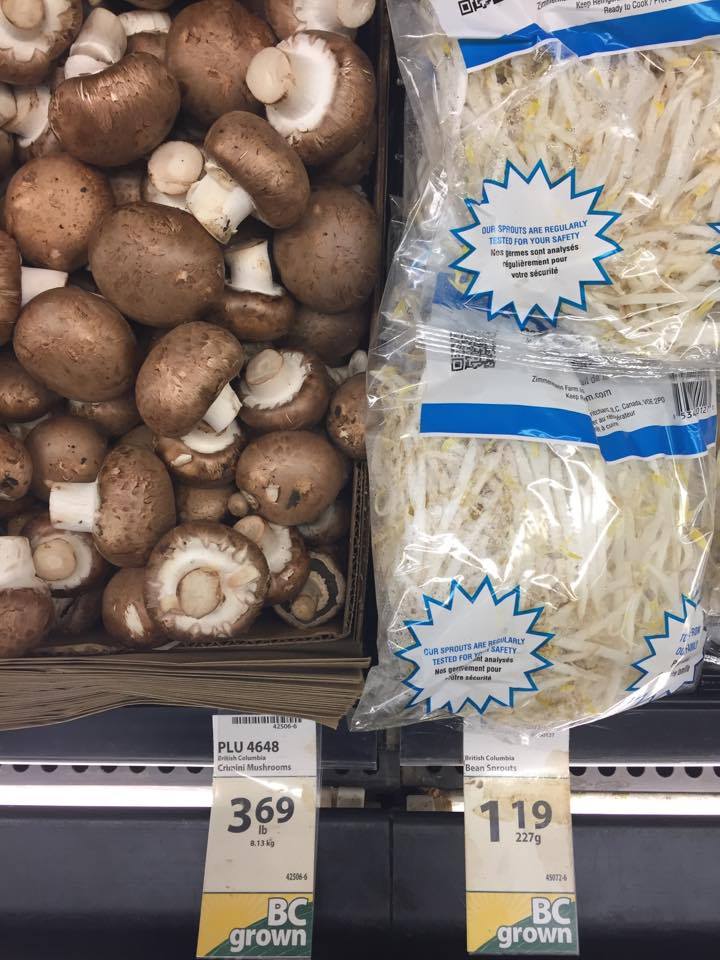Canadian Migrant Worker Programs: To have a cake and eat it too
This photograph, picturing Canadian grown vegetables, was taken in a supermarket in UBC campus, Vancouver on March 5, 2017. Domestically produced food may be positively associated with little impact on the climate, support of the Canadian economy and working conditions in line with Canadian law. However, many workers in Canadian farms are migrants, working under the Seasonal Agricultural Worker Program (SAWP). The program aims to help farmers find labour when their labour needs cannot be met by the domestic work force. Despite the legal human rights protection for workers in Canada under Canadian law, this does not seem to be the practical reality for people working under SAWP (McLaughlin, 2016).
The program is addressed to citizens of Mexico or certain Caribbean countries, and the employment in the farms last for maximum eight months (Hire a temporary worker through the Seasonal Agricultural Worker Program – Overview, 2016). People working under the program cannot gain a legal Canadian citizenship, despite many of them working in Canada for decades (McLaughlin, 2016). This makes family separation inevitable. Workers travel back and forth between Canada and their home country where they meet their families. Thus children grow up with absent parents (mainly fathers), and mothers live as single parents in the home country with the full responsibility of the domestic work.
The employment is linked to one employer, thus when the employment contract ends with that specific employer, the worker no longer has the right to stay in Canada (Walia, 2010). Even though the human rights of workers under SAWP are protected by Canadian law in theory, the workers’ deportability has shown to make these regulations rather weak in practice.
The employer is free to choose gender and national origin of the workers, and further who will be welcome back or not. This increases the workers’ vulnerability, as their entire families often are dependent on the salary from the farm (McLaughlin, 2016). Furthermore, an employer who violates their legal duties towards the workers will have the work permits connected to the business revoked (After hiring a temporary worker, 2016). This makes it difficult for workers to speak up about poor working conditions and other violations of the employment contract. Behaving in an undesirable way or reporting the employer may imply the end of employment and result in deportation which causes devastating consequences for the family.
Agricultural work is one of the most dangerous sectors in Canada, with a high rate of work related injuries and death (Walia, 2010). However, when a migrant worker is injured or ill, and no longer can work for the employer, this person is often directly deported to the home country without receiving the appropriate medical care in Canada (Marchitelli, 2016).
This illustrates how SAWP facilitates the exploitation of workers in Canada, specifically from third world countries. Those who can contribute to the Canadian economy as cheap and disposable labour, can achieve a temporary visa through SAWP. The disposability of these workers, as an effect of the program, further demonstrates how the possibility to become a Canadian citizen is a practice of social differentiation. It is a matter of national origin, class and gender. Migrant agricultural workers work for Canadian employers, in Canada, for decades, but lose their protection of their human rights and right to remain in the country, as soon as they stop contributing (Marchitelli, 2016). Furthermore, the employers’ right to choose gender and national origin of their workers makes the opportunity to work under these programs based on gendered and racial stereotypical views of the employer (McLaughlin, 2016). This does not only affect the individual worker, but split families and reinforces the labour division in the worker’s society of origin. As mainly men are chosen as agricultural labour, their wives are forced to take the complete responsibility of the domestic work. Hence, through such programs as SAWP, the unequal power relation between Canada and workers from third world countries is used. Despite the exploitation of migration workers, through the threat of deportation, Canada can retain its identity of being a country which protect human rights and ban discrimination.
Works Cited
- Government of Canada. (2016, March 14). After hiring a temporary worker. Retrieved 2017, March 3 from http://www.cic.gc.ca/english/work/employers/hire-after.asp.
- Government of Canada. (2016, January 25). Hire a temporary worker through the Seasonal Agricultural Worker Program – Overview. Retrieved 2017, March 3 from https://www.canada.ca/en/employment-social-development/services/foreign-workers/hire/agricultural/seasonal-agricultural.html.
- Marchitelli, R. (2016, May 16). Migrant worker program called ‘worse than slavery’ after injured participants sent home without treatment. Retrieved 2017, March 3 from http://www.cbc.ca/news/canada/jamaican-farm-worker-sent-home-in-a-casket-1.3577643.
- McLaughlin, J. (2016, June 16) Canada’s migrant agricultural workers deserve full and equal rights. Here’s why, Retrieved 2017, March 3 from http://tvo.org/article/current-affairs/shared-values/canadas-migrant-agricultural-workers-deserve-full-and-equal-rights-heres-why.
- Walia, H. (2010). Transient servitude: migrant labour in Canada and the apartheid of citizenship. Race & Class 52, no. 1, pp. 73-74
